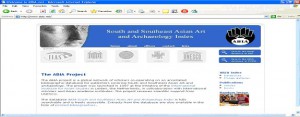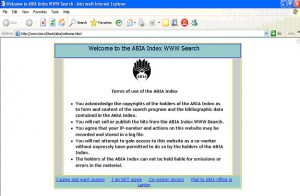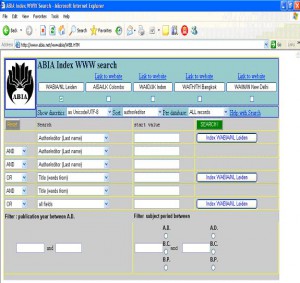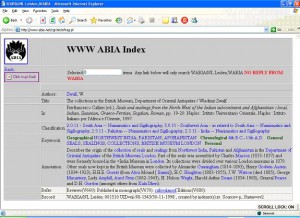
THE ABIA PROJECT
- Genesis
- Objectives
- Publications
- Indexes
- Its Benefits
- Project at IGNCA
- Other Participating Countries
- ABIA Workshop
- References
- Photographs
DOWNLOAD
ABIA South and Southeast Asian Art and Archaeology Index Project at IGNCA, New Delhi
The ABIA project is a global network of scholars co-operating on an annotated bibliographic database for publications covering South and Southeast Asian Art and Archaeology. The project receives scientific support from UNESCO also.
ABIA stands for Annual Bibliography of Indian Archaeology that was published by the Kern Institute in Leiden during 1926-73. The ABIA is a unique and ambitious scheme of annotated bibliographic compilations on Indian Arts and Archaeology, which used to be brought out annually by a group of Dutch Scholars from the early part of the twentieth century. The ABIA was the brain child of Professor J. Ph. Vogel, one of the most notable Indologists of the 20th century. The name ABIA was coined by a group of Dutch Scholars, who started this series in 1926. For about half a century the ABIA publication dominated the world of bibliography and scholars of the world depended on it to know what has been published and where are the India’s past? Running for about half a century and publishing several volumes of annual and random numbers, the ABIA rendered unique service to Indian studies between 1926 and 1984 and kept scholars engaged on Indian arts and archaeology under great debt. Perhaps the loss of colonies in Southeast Asia and such other factors led South Asian Scholars in the Netherlands to face a crisis in the 80s, ultimately resulting in the suspension of ABIA publication in 1984. This loss was immensely felt by every body as there was nothing of the kind to fill the vacuum caused by its exit.
Though suspended for about a decade in the late eighties and early nineties, this pioneering effort was revived in 1995 mainly through the efforts of scholars from the International Institute for Asian Studies (IIAS), the Netherlands. The Dutch again found willing and enthusiastic partners in Sri Lanka, Thailand and Indonesia in 1995. The Dutch created a special fund for running the ABIA Office in Leiden to publish the annual number to input of information on the net and to run the electronic mail coordinate the work carried out by the participating units in South and Southeast Asia, and to meet the cost of the annual workshops, advisory broads and the editorial committee meetings, some funds were also provided by them to assist centers in South Asian and majority of Southeast Asian countries.
In 1996, the International Institute for Asian Studies (IIAS), Leiden put forward a proposal to resume the bibliography. The new bibliography is called ABIA South and Southeast Asian Art and Archaeology Index, briefly ABIA Index. The new ABIA had to keep pace with the time, widen its net to include both South Asia and Southeast Asia plan not only the annual numbers in print comprising the most significant researches, but also accommodate every bit of information on line and made the information immediately available to any one any where in the world accord to the independent position and status to the participating partners in the project earn the respect of orientalists in Europe, America, Australia, Russia and China, and at the same time retain the basic character of the 1926 ABIA, making India the largest publishing nation of Oriental studies in the world.

The basic objective(6) on ABIA project is to compile and maintain a bibliographic electronic online database which supplies annotated records, covering the subject pre and proto history, historical archaeology, ancient and modern art history, material culture, epigraphy and paleography, numismatics and sigillography. An Annotated Bibliography extracted from the database is published annually in a printed version in addition to CD-ROM version of ABIA Index.
The database ABIA South and Southeast Asian Art and Archaeology Index is fully searchable online and is freely accessible at http://www.abia.net. Extracts from the database are also available in the form of printed bibliographies. Two volumes have been published so far, containing total 3,356 annotated and key word-indexed references to publications between 1996 and 2001. More details are available at http://www.abia.net for upcoming publications.

The ABIA Database covers publications from 1996 onwards. All the records published in ABIA volume I & II are available on ABIA NET. More than 12000 records are available in the online database. One may search with terms, e.g., author’s name; words from the title, ISBN number etc.


Since the re-start of the Project, in January 1997 three regional Centres of expertise have participated in the production: the IIAS in Leiden, the Netherlands; the PGIAR (Postgraduate Institute of Archaeology, University of Kelaniya in co-operation with the CCF (Central Cultural Fund) Colombo, Sri Lanka; and the SPAFA (Regional Centre for Archaeology and Fine Arts in Southeast Asia) in Bangkok, Thailand.
The first ABIA Index edited by Karel R.Van Kooij appeared in 1999 that included the printed bibliographic records collected during 1997-1998 while the second one in two parts was brought out in 2002 and edited by Ellen M. Raven. It consists of 2050 records selected from the database processed during 1998-2001. The third volume of ABIA Index is expected in 2010 having participation of scholars from India, Indonesia and other parts of South and Southeast Asia besides the three regional coordinating Centres.
Structure of the records(2)
A record in the book contains the following elements ;
- Record number and the name of the first author/editor
- Bibliographic description proper
- Language code
- Keywords
- Annotation
- Code indicating the documentalist (indexer)
- UID code (=unique identification code) identifying each record in the database and the book
- References to related publications
ABIA Sample Record(2)
1308 Kooij, Karel R. van
ABIA South and Southeast Asian art and archaeology index, volume one /ed. by Karel R. van Kooij, Ellen M. Raven (coord. ed. for South Asia), Marijke J. Klokke (coord. ed. for Southeast Asia), S. Settar and Doris Yapa (eds for South Asia), Hasan Djafar and Wilasinee Thabuengkarn (eds for Southeast Asia). London: Kegan Paul; Leiden (etc.) : International Institute for Asian Studies, 1999.597 p., ill. (Studies from the International Institute for Asian Studies). ISBN 0-7103-0625-3. (eng)
South Asia ; Southeast Asia; ABIA: bibliographies; archaeology; arts; modern art; material culture; epigraphy; palaeography; numismatics; sigillorgraphy
Annotated and key-word indexed bibliography covering the prehistory, archaeology, arts, material culture, epigraphy, palaeography, numismatics and sigilography of South Asia, Southeast Asia and regions culturally linked to those areas (Afghanistan, southern Central Asia, and Chinese Silk Road area. Tibet and South China ). Includes over 1300 references to publications from 1996 and 1997 mostly. Also includes an essay by Karel R. van Kooij on ‘meaning in early Buddhist art’, and by Edi Sedyawati on ‘research by Indonesian archaeologists between 1977 and 1997’. Successor to the 23 volumes of the Annual Bibliography of Indian Archaeology (ABIA) that were compiled at the Kern Institute of Indology, Leiden between 1926 and the middle of the 1970s, covering the period 1926-1972.
(IND=er) (UID code-99-1561/19-01-1999)
Author Index
The author index lists the standardized form of the names of authors, editors and others involved in a publication and mentioned as such on the title page or header of an article.
Geographical Index
The Geographical index contains names of mountains, rivers and river basins, plains, lakes etc., and of villages, sub districts, districts, provinces, countries and larger regions.
Subject Index
The subject index contains general descriptive terms or keywords including: fields of study
- Scholarly approaches
- Archaeological and art historical terms
- (Pre-)historic periods
- Kingdoms
- Dynastic names
- Cultures
- Ancient cities
- Architectural structures
- Works of art, etc.
- Motifs
- Gods and goddesses
- Sites
- Texts
- Artifacts
- Forms of material culture
- Languages (rendered without diacritics)
Annotation(2)
The annotation attempts to be concise and to elucidate the context, the inherent interest and the potential value of the publication. Its maximum size is circa 1,000 characters (circa 150 words). Although at times the editors borrow from abstracts supplied in the publications themselves, the style of the ABIA abstract conforms to a format optimized for database searches via keywords from thesauri.
If the title of the publication is not in English, the first sentence of the annotation provides a translation of the title in Italics. In the annotation, titles of texts and terms in languages other than English have also been put in Italics.
ABIA Index Coverage(2)
The regions, subjects and materials covered by the ABIA South and Southeast Asian Art and Archaeology Index are the following:
Regions
- South Asia: Bangladesh, Bhutan, India, Nepal, Pakistan, Sri Lanka and the Maldives
- Southwest Asia
- Central Asia and East Asia as related to South Asia
- Southeast Asia: Brunei Darussalam, Cambodia, Indonesia, Laos, Malaysia, Myanmar, Philippines, Thailand and Vietnam
- East Asia and the pacific as related to Southeast Asia.
Subjects
- Pre-and protohistory
- Historical archaeology
- Ancient art history
- Modern art history
- Epigraphy and Palaeography
- Numismatics and Sigillography (seals)The performing arts and ancient history are not included.
Materials
- Monographs
- Articles in monographs
- Articles in periodicals
- Unpublished Ph.D. theses
- Any ‘grey’ literature of an academic level
Revised editions and translated publications are included, but unaltered reprints are not.
Languages(2)
The language of the database is English. However, it is our aim to process information on publications in any language. In practice, the ABIA Index covers publications in those languages with which the ABIA editors and annotators are familiar or for which they receive help from others. Other than English include a translation of the title at the beginning of the annotation.
Software
The bibliographic data are documented with the help of CDS/ISIS, a text retrieval programme designed and distributed by UNESCO.
Classification Code(2)
The ABIA Index Database and books use a broad classification with three digit numbers.
- The first two digits indicate the geographic region
- The third digit refers to the form of the publication, or its subject matter
Geographical Classification (2)
1.0 South and Southeast Asia 2.0 South Asia 6.0 Southeast Asia 2.1 2.2
2.3
2.4
2.5
2.7
2.8
Bangladesh Bhutan
India
Nepal
Pakistan
Sri Lanka
Maldives
6.1 6.2
6.3
6.4
6.5
6.6
6.7
6.8
6.9
6.10
Brunei Darussalam Cambodia
Indonesia
Laos
Malaysia
Myanmar
Philippines
Singapore
Thailand
Vietnam
3.0 4.0
5.0
Southwest Asia as related to South Asia (e.g., Afghanistan, Iran) Central Asia as related to South Asia (e.g., Uzbekistan and Tajikistan)
East Asia as related to South Asia (e.g., the region of Tibetan culture)
7.0 8.0
East Asia are related to Southeast Asia (e.g., South China) The Pacific as related to Southeast Asia ( The region of Austronesian culture.
Volume 1: ABIA: South and Southeast Asian Art and Archaeology Index – Volume 1 edited By Karel R. van Kooij (1)
Geographic spread of records printed in ABIA Index 1
On South and Southeast Asia general 39On South Asia and its periphery 635
On Southeast Asia and its periphery 632
Total number of records 1306
2. ABIA: South and Southeast Asian Art and Archaeology Index: Volume 2 edited by Ellen M.Raven & Helga I.Lasschuijt
Geographic spread of records printed in ABIA Index 2
On South and Southeast Asia general 64On South Asia and its periphery 1336
On Southeast Asia and its periphery 650
Total number of records 2050
(Source: introduction to ABIA Index 2, p. xxvii)
ABIA Index 2
Classification+ Country record no. in book amount
1 S&SE Asia 1307-1370 64
2.0 South Asia 1371-1577 207
2.1 Bangladesh 1578-1620 43
2.2 Bhutan 1621-1626 6
2.3 India 1627-2205 579
2.4 Nepal 2206-2286 81
2.5 Pakistan 2287-2420 134
2.7 Sri Lanka 2421-2523 103
2.8 Maldives 2524-2526 3
3 SW Asia 2527-2587 61
4 Central Asia 2588-2622 35
5 East Asia 2623-2706 84
6.0 SE Asia 2707-2787 81
6.1 Brunei Darussalam 2788 1
6.2 Cambodia 2789-2859 71
6.3 Indonesia 2860-3065 206
6.4 Laos 3066-3077 12
6.5 Malaysia 3078-3102 25
6.6 Myanmar 3103-3162 60
6.7 Philippines 3163-3189 27
6.8 Singapore 3190-3195 6
6.9 Thailand 3196-3263 68
6.10 Vietnam 3264-3348 85
7 East-Asia 3349 1
8 Pacific 3350-3356 7
Total 2050
ABIA Index volume 2 – contributing sources of the records (2) (as indicated by library origin)
Library/annotator Processed at Amount contributed to V2 Records ON various countries in V2 (joint effort) S&SE Asia 64
South Asia general 207
Sri Lanka Sri Lanka 215
Sri Lanka 103
Sri Lanka Sri Lanka
Maldives 3
India Sri Lanka 106
India 579
Bangladesh Sri Lanka 29
Bangladesh 43
Pakistan Sri Lanka 5
Pakistan 134
Nepal Sri Lanka 11
Nepal 81
Bhutan Sri Lanka 1
Bhutan 6
Leiden Netherlands
SW Asia 61
Russia Netherlands 37
Central Asia 35
Leiden Netherlands
East Asia 85
Leiden Netherlands
Pacific 7
Leiden Netherlands
SE Asia general 81
Leiden Netherlands
Brunei Darsussalam 1
Leiden Netherlands
Cambodia 71
Indonesia Netherlands 70
Indonesia 206
Leiden Netherlands Laos 9
Malaysia Netherlands 23
Malaysia 25
Leiden Netherlands Myanmar 60
Leiden Netherlands Philippines 27
Leiden Netherlands Singapore 6
Thailand Netherlands 9
Thailand 68
Leiden Netherlands Vietnam 85
Netherlands Netherlands 1441
NL in France NL in UK
Netherlands Netherlands
12
81
Total
2050
Total 2050
It is in this way, ABIA Project is a collaborative effort of many countries in South and Southeast Asian regions. To open an international network for this academic field is not a luxury but a necessity to keep our Archaeological and Art historical memory in order to make it accessible to future generation. It is expected that the new ABIA South and Southeast Asian Art and Archaeology Index will fulfill its special assignment and make the scholarly world familiar with the art historical and archaeological work that is being done at academic institutions and by scholars all over the world. The ABIA Index database is useful for art historian, archaeologists, Asia specialists, anthropologists, numismatists, historians and epigraphists. It should also appeal to librarians, curators, educational service staff and collectors of Asian art and coins.
Publication of Bibliographies and the development of bibliographic databases are some of the basic objectives of IGNCA. Under these programmes a number of bibliographies have been published. The participation of IGNCA to ABIA project is to fulfill the above objectives as well as to strengthen International co-operation amongst Arts and Archeology institutions in South and Southeast Asia.
In ABIA Project, Indian activities started with Prof. Settar, Dharwad, India, probably in 1998. In December 2001, Indira Gandhi National Centre for the Arts is able to associate itself with the ABIA project and assist in getting the required entries on Indian publication. MOU signed between IGNCA & PGIAR in Oct. 2002 to continue the work. From 1st January 2007 IGNCA has become the coordinating office for ABIA Project for next five years. Under this project it is planned to establish a regional network of individual scholars and institutions in India to gather information on various publications in the area of interest of ABIA Project. Apart from the contributions of records to ABIA, this project will also help in strengthening IGNCA’s Bibliographic activities. IGNCA will be planning, publication of ABIA volume IV within next two years of this project.
OTHER PARTICIPATING COUNTRIES(2)
INTERNATIONAL INSTITUTE FOR ASIAN STUDIES
The International Institute for Asian Studies (IIAS) is a postdoctoral research centre based in Leiden and Amsterdam, the Netherlands. Its main objectives to encourage the study of Asia and to promote national and international cooperation in this fields. The geographic scope of the institute covers South Asia, Southeast Asia, East Asia and Central Asia. The institute focuses on the humanities and the social sciences and, where relevant, on their interaction with other sciences.
POSTGRADUATE INSTITUTE OF ARCHAEOLOGY
The Postgraduate Institute of Archaeology (PGIAR) is a coordinator, national institution engaged in archaeological education, training, research and popularization. It was established by ordinance in 1986 and is one of the two postgraduate institutes of the University of Kelaniya. A Board of Management that has ex-officio representation from all institutions in Sri Lanka directly or indirectly engaged in archaeology administers the PGIAR.
THE SEAMEO REGIONAL CENTRE FOR ARCHAEOLOGY AND FINE ARTS – SPAFA
The SEAMEO Regional Centre for Archaeology and Fine Arts is the coordinating unit in Bangkok of a project, under the aegis of the Southeast Asian Ministers of Education Organization (SEAMEO) that aims to cultivate awareness and appreciation of cultural heritage, to promote and help enrich archaeological and cultural activities in the region, and to further professional competence in the fields of archaeology and fine arts. SEAMEO-SPAFA operates as an autonomous, International institution hosted by the Government of Thailand.
http://www.seameo.org/centers/spafa.htm
ABIA project also represented by some individual scholars and institutions from following countries:
- Bangladesh
- Bhutan
- Cambodia
- Indonesia
- Malaysia
- Nepal
- Pakistan
In January 1997 the project officially started with the first ABIA workshop which was hosted by the PGIAR in Colombo (Sri Lanka). A second workshop followed in August 1997 hosted by SPAFA in Bangkok (Thialand). The thirds one took place in December 1998 at IIAS in Leiden (the Netherlands). The fourth workshop at Dharwad in Karnataka (India) was followed by the 5th Workshop of ABIA at Kediri (Indonesia). The 6th ABIA Workshop was hosted by IGNCA in New Delhi (India) on December 1-2, 2003. 7th Workshop and Seminar of ABIA was arranged at PGIAR, Colombo, Sri Lanka during 30th July to 2nd August, 2004. The 8th ABIA Annual Workshop and Seminar on “Asian Earth Ceramics of South and Southeast Asia” held at International Institute of Asian Studies, Leiden University, Leiden, the Netherlands during 11th January to 13th January, 2006. These International meetings are being held regularly to strengthen the communication lines between editors and offices, henceforth 9th ABIA workshop has been organized at Dhaka, Bangladesh during February 12-13, 2007 and the 10th ABIA Workshop was hosted by IGNCA, New Delhi(India) on December 7-8, 2009 (view Photographs)
- ABIA: South and Southeast Asian Art and Archaeology index, Vol.1/ ed. by Karel R. van Kooij.-http://www.iias.nl/host/abia/node/12
- ABIA: South and Southeast Asian Art and Archaeology index, Vol.2/ ed. by Ellen M. Raven and Helga I. Lasschuijt.- Leiden: E.J.Brill, 2002
- On the history of the ABIA Index software/ Anton van de Repe
- Jean Philippe Vogel: a Dutchman who went Indian/ Gerda Theuns-De Boer in IIAS Newsletter 22(2000);http://www.iias.nl/host/abia/node/72
- A giant’s step to Sri Lanka: ABIA’s chair transferred/ Ellen M. Raven in IIAS Newsletter, 27th March(2002); http://www.iias.nl/host/abia/node/10
- www.abia.net







